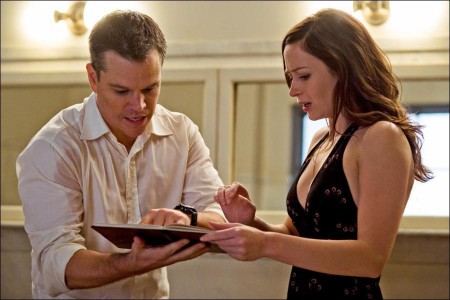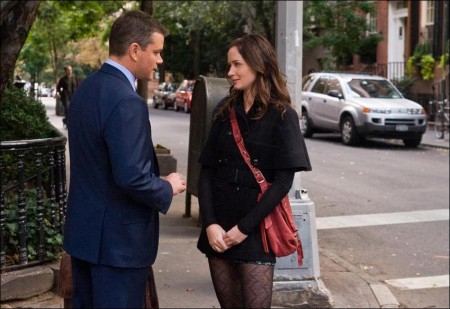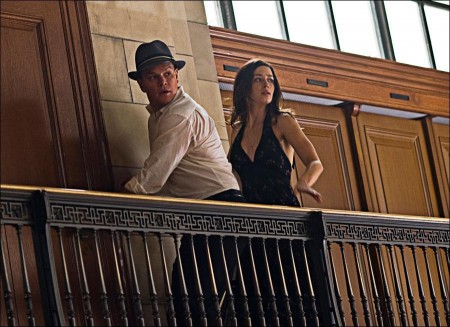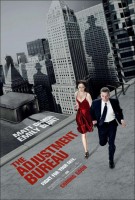Taglines: Your fate has been adjusted.
Do we control our destiny, or do unseen forces manipulate us? Matt Damon stars in the thriller The Adjustment Bureau as a man who glimpses the future Fate has planned for him and realizes he wants something else. To get it, he must pursue the only woman he’s ever loved across, under and through the streets of modern-day New York.
On the brink of winning a seat in the U.S. Senate, ambitious politician David Norris (Matt Damon) meets beautiful contemporary ballet dancer Elise Sellas (Emily Blunt)–a woman like none he’s ever known. But just as he realizes he’s falling for her, mysterious men conspire to keep the two apart. David learns he is up against the agents of Fate itself–the men of The Adjustment Bureau–who will do everything in their considerable power to prevent David and Elise from being together. In the face of overwhelming odds, he must either let her go and accept a predetermined path…or risk everything to defy Fate and be with her.
The Adjustment Begins
The Adjustment Bureau is written for the screen and directed by George Nolfi (writer of Ocean’s Twelve, co-writer of The Bourne Ultimatum). It is based on a short story by Philip K. Dick (“Total Recall,” “Minority Report” and “Blade Runner”).
George Nolfi was working on another script when his longtime friend and producing partner, Michael Hackett, brought up Philip K. Dick’s short story “Adjustment Team” during a phone call. Though he had not yet secured the rights to the story, Hackett had a solid working relationship with Dick’s estate and wanted to pursue optioning and developing the project. When the producer pitched Nolfi the concept of “Fate personified” trying to prevent a man from being with the woman he loves, Nolfi was intrigued. “He got very interested very quickly,” recounts Hackett. “In fact, he requested that we meet that day to talk more.”
Though Dick’s work can be both prescient and dystopian, the central conceit of “Adjustment Team”—that Fate is a group of people among us— melded with a love story, struck Nolfi as an original concept for a film that could dig into some of life’s “big questions” in a thrilling and compelling way. Flash forward to Nolfi’s work with Matt Damon on Ocean’s Twelve; during this time, he and Hackett pursued the adaptation of what would become The Adjustment Bureau. They were certain that they wanted Damon as their lead, and Nolfi began to write the part of his protagonist with Damon in mind. Observes the writer/director: “Matt’s the best everyman that we’ve got, and because of that he’s extremely believable in a love story.”
Damon’s interest was piqued by this tale of a man who stumbles on a vast, powerful and unseen world that exists on the periphery of our own. He told the filmmakers that if future drafts looked as good, he would be ready to join. “George has been a friend and collaborator for a long time,” notes Damon. “He brought this script to me that he’d written on spec…because he wanted to direct it. I was a big believer in him and felt he could do it.”
Nolfi took the opportunity to polish the idea before revisiting the project with Damon during The Bourne Ultimatum, which Nolfi also co-wrote. “I got the script to a place where I thought it was ready for Matt,” Nolfi says. “Once he said he was interested in being involved formally…it was a back and forth collaborative process.” Together, the colleagues had many philosophical conversations about the material; from these discussions came ideas that Nolfi used to improve the arc and build out his story.
Damon was impressed with the manner in which Nolfi expanded Dick’s work and made it particularly relevant for a modern audience. The performer com – mends: “George was specific about everything—from the look of it to the types of people that he wanted to cast. He saw what he wanted to do with this piece.”
Since Damon and Nolfi had both worked previously with producer Chris Moore, they agreed that he would be a great partner with whom they could navigate the development of this ambitious project. Of his inter est in joining the team, the producer comments: “I was interested in George’s take on what control we have over our own lives. I also loved that the material crosses a number of genres. There are thriller elements, action and a great love story—as well as a personal crisis about what you believe in and who are you going to be. All that, plus a huge action movie about trying to outrun your Fate…that’s what popcorn movies are supposed to be.”
Rounding out the producing team was notable New York City filmmaker Bill Carraro, whose experience both in development and in physical production would prove invaluable. The producer, who first partnered with Nolfi on The Sentinel, worked with the director for more than a year and mapped out how to physically shoot the numerous set pieces and locations written into the script as the production navigated across Manhattan.
Carraro, with his extensive experience in visual effects, understood that Nolfi required the effects be seamless in order to work. He says: “We track the men of The Adjustment Bureau from one environment into another every time they open a door. That’s apt to throw you into a lot of different locations.” With the core team in place, the project soon secured funding with Media Rights Capital and production was set in motion.
The original character from Dick’s short story is an insurance salesman, but for his protagonist, Nolfi felt strongly that David Norris should be a politician.
For his main character, Nolfi imagined a charismatic and popular Democratic congressman from the rough-and-tumble streets of Brooklyn. Producer Hackett explains this logic: “Picking a poli tician allowed us a character whose decision can matter to people beyond himself. If he chooses to stay on his career path, he can actually, under the right circumstances, do great things for millions of people. This weighs against his own happiness and what’s best for him as a person.”
Adds producer Moore, whose partnership with Damon extends back to the Oscar-winning Good Will Hunting: “David Norris and Matt Damon… that is hard to sep – arate. To some extent, it’s because George wrote the script for Matt. He is one of the few guys out there who literally becomes the character.”
At the beginning of Nolfi’s story, Congressman David Norris boasts a double-digit lead in the polls during his senatorial campaign. Explains Nolfi of David’s rock-star appeal: “He’s the youngest con gress – man ever elected to the House of Represen tatives. He’s got an outsized reputation because he’s a big personality.”
Although David’s affable nature and straightshooting demeanor have made him a clear public favorite, he is, after all, only human. “He has a tendency to mess things up for himself,” Damon reflects. “He’s a little too honest sometimes…he’s not quite political enough.” It is just this shortcoming that causes David an embarrassing incident that costs him his first run for the United States Senate.
“Due to his youthful exuberance, he makes a mistake,” says Hackett. “Dig a little deeper, and someone examining the character might say that he had a subconscious desire to derail the path he was on so that he could find his real self.” David’s misstep, which is picked up by the press at the height of his campaign, costs him his lead in the polls and, eventually, the election.
Though the Bourne and Ocean’s films have women in strong but supporting roles, this is one of the first projects in which Damon has been cast as the romantic lead and played someone who is specifically, and fatefully, linked to a lover. As written, David’s love interest needed to be a woman for whom he would move mountains.
On the eve of the election, before David is to give his concession speech at The Waldorf Astoria hotel, he takes a moment to collect himself in the men’s room. Explains Nolfi: “He’s devastated that he’s lost the election. Not just for himself, but he feels like he brought all these people along for the ride and let them down.”
It is in the washroom that he encounters stunning dancer Elise Sellas, hiding from hotel security after she was found crashing a wedding. David finds her charming and irresistible, while she recognizes him as the popular politico who is about to lose the election. He is instantly, and fatefully, drawn to her and starts to fall head over heels in love…something The Adjustment Bureau never intended. For the next several years, David will chase the elusive Elise and try and outwit what the men controlled by Fate have planned for him. And it could cost him, and her, everything.
So who exactly is this group who manipulates us from a position of unseen, immutable power? Who are its agents that seem to be no – where and everywhere all at once? “They have a bureaucratic system that allows them to manipulate things in such a way that our lives are subtly adjusted, nudged, bumped, moved, encouraged, coaxed and cajoled in the direction that they have determined we should be going in,” sums Hackett. “The Bureau represents a cipher of all interpretations people may have for ‘the other.’ That other power, that thing outside yourself that guides your choices. It’s certainly not accidental that The Adjustment Bureau, distilled to its purest form, echoes a number of the great belief systems around the world, religious or otherwise.”
Nolfi extrapolates upon his concept of the organization that drives his tale: “They’re an expression of a higher power, so it’s not like a government agency that doesn’t want you to do something. They have powers that go way beyond what the earthly powers of an intelligence organization would be. They set us on the course that we are supposed to be set onto so we will follow the grand scheme, or the grand plan. To them they just work at a bureau. They might as well work in the IRS; they’re just doing their jobs.”
The Adjustment Bureau
Directed by: George Nolfi
Starring: Matt Damon, Emily Brunt, Lisa Thoreson, Florence Kastriner, Phyllis McBryde, Natalie Carter
Screenplay by: George Nolfi, Philip K. Dick
Production Design by: Kevin Thompson
Cinematography by: John Toll
Film Editing by: Jay Rabinowitz
Costume Design by: Kasia Walicka-Maimone
Set Decoration by: Susan Bode
Art Direction by: Stephen H. Carter
Music by: Thomas Newman
MPAA Rating: PG-13 for brief strong language, some sexuality and a violent image.
Studio: Universal Pictures
Release Date: March 4, 2011
Hits: 216







